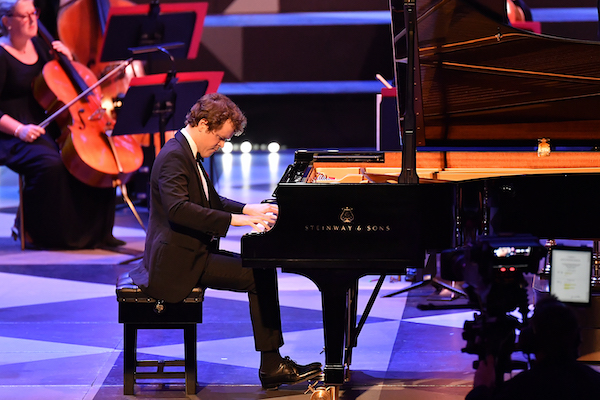 United Kingdom BBC Proms Live – Ravel, Shostakovich, Mozart: Benjamin Grosvenor (piano), Jason Evans (trumpet), Philharmonia Orchestra / Paavo Järvi (conductor). Broadcast Live on BBC iPlayer and BBC Radio 3 from the Royal Albert Hall, 9.9.2020. (RB)
United Kingdom BBC Proms Live – Ravel, Shostakovich, Mozart: Benjamin Grosvenor (piano), Jason Evans (trumpet), Philharmonia Orchestra / Paavo Järvi (conductor). Broadcast Live on BBC iPlayer and BBC Radio 3 from the Royal Albert Hall, 9.9.2020. (RB)

Ravel – Le Tombeau de Couperin
Shostakovich – Concerto for Piano, Trumpet and Strings in C minor Op.35
Mozart – Symphony No.41 in C major K551 ‘Jupiter’
The two 20th-century works which opened this Prom both borrowed from the past. The Shostakovich Concerto for Piano Trumpet and Strings is full of quotations from Beethoven, Haydn and various folk dances while the four movements of Ravel’s Le Tombeau de Couperin are based on the French Baroque suite. Mozart’s monumental ‘Jupiter’ Symphony also includes quotations from his earlier works. Esa-Pekka Salonen had to withdraw from the concert and Paavo Järvi helpfully took his place at short notice.
Ravel’s initially composed Le Tombeau de Couperin as a suite for piano. He began work on the piece in 1914 but the First World War interrupted his progress and it was not completed until 1917. It was first performed by Marguerite Long in Paris in April 1919 and the last movement of the suite is dedicated to Long’s husband who died in the war. The word ‘tombeau’ refers to a piece written as a memorial and each of the work’s movements is dedicated to friends of the composer who died fighting in World War I. Ravel scored four of the movements of the suite for small orchestra in 1919 omitting the fugue and toccata.
The orchestral version of Le Tombeau requires a virtuoso oboist and the Philharmonia’s Tom Blomfield rose magnificently to the challenge, giving a technically accomplished and beautifully polished performance throughout. The woodwind arabesques which opened the Prélude were artfully executed and conveyed the refined Gallic sensibility of the work. Järvi skilfully controlled tempo and dynamics and coaxed a wonderful blend of sound from his players. The dotted rhythms of the Forlane had bounce and elegance propelling the music along nicely, while the lyrical phrases of the Menuet were beautifully shaped. The Philharmonia’s brass brought a raucous, boisterous energy to the Rigaudon while the orchestral entries were tightly controlled by Järvi. This was an excellent start to the concert.
Benjamin Grosvenor joined the Philharmonia’s strings and principal trumpeter, Jason Evans, for Shostakovich’s Concerto for Piano, Trumpet and Strings. Shostakovich completed the work in 1933 and it was experimental in its neo-Baroque scoring for trumpet and strings. Shostakovich’s sardonic wit is prevalent throughout and there are quotations from Beethoven, Haydn, various folksongs, as well as, well as parodies of Shostakovich’s own themes. Shostakovich was a virtuoso pianist; he played the piano part at the premiere and it is a technically demanding work for the pianist.
I very much enjoyed Grosvenor’s performance of the opening section of the first movement which was nuanced and poetic. In the ensuing section, scurrying strings combined with dizzying passagework on the piano and trumpet fanfares to excellent effect. Some of the exchanges between orchestra and soloist were a little ragged, although it is worth bearing in mind that there may have been less time to prepare as the advertised conductor was indisposed. Jason Evans produced beautifully controlled soft playing at the end of the first movement. The mournful slow movement was tinged with Russian melancholy, first from Grosvenor in the early part of the movement and then from Evans in the final section where his muted trumpet created a feeling of desolation and loneliness. I would have liked a little more improvisatory freedom from Grosvenor in the moderato third movement. However, piano, trumpet and strings created a real adrenaline rush in the ‘Rossini meets Mickey Mouse’ finale. Järvi was alive to the raucous humour and his facial expressions were like those of a silent film actor responding to moments of high comedy. Grosvenor’s handling of the cadenza was a high-octane, virtuoso tour de force as we saw his fingers traversing the keys at dizzying speed. Piano, trumpet and strings combined one final time in the uproarious coda, driving the work to its thrilling conclusion.
The final work on the programme was Mozart’s ‘Jupiter’ Symphony which the composer wrote in 1788, three years before his death. Järvi spoke about this work in the interval and he clearly regards it as one of the greatest works in the symphonic repertoire. Mozart infuses this work with a wealth of emotions and it combines the high drama which one finds in the composer’s operas with textbook symphonic development.
Järvi adopted a fairly brisk tempo in the opening Allegro and he and the orchestral players paid close attention to phrasing and articulation throughout. The dynamic contrasts were closely observed and Järvi did an excellent job synthesising the diverse thematic material including the brass fanfares, the more lyrical material on the strings and woodwind, the stormy minor key interludes and the operatic quotations. The Andante cantabile had a lovely lyrical flow although a slightly more restrained tempo would have allowed us to enjoy more the moments of supreme lyrical beauty. The Menuetto was a moment of unalloyed joy with Järvi capturing perfectly the lilt and sway of the Austrian ländler. The opening of the finale was slightly rushed although the orchestral players soon settled at a comfortable tempo. Some of the entries could have been a little more tightly coordinated and the Philharmonia were not quite able to produce the perfection which this music demands. Having said that there was some admirable playing here and an infectious enthusiasm from many of the players.
Overall, this concert was a bit of a musical mixed bag, but it featured some very fine playing.
Robert Beattie
